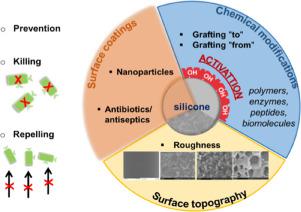Acta Biomaterialia ( IF 9.7 ) Pub Date : 2020-11-16 , DOI: 10.1016/j.actbio.2020.11.020 Mylan Lam , Véronique Migonney , Céline Falentin-Daudre

|
Silicone implants are widely used in the medical field for plastic or reconstructive surgeries for the purpose of soft tissue issues. However, as with any implanted object, healthcare-associated infections are not completely avoidable. The material suffers from a lack of biocompatibility and is often subject to bacterial/microbial infections characterized by biofilm growth. Numerous strategies have been developed to either prevent, reduce, or fight bacterial adhesion by providing an antibacterial property. The present review summarizes the diverse approaches to deal with bacterial infections on silicone surfaces along with the different methods to activate/oxidize the surface before any surface modifications. It includes antibacterial coatings with antibiotics or nanoparticles, covalent attachment of active bacterial molecules like peptides or polymers. Regarding silicone surfaces, the activation step is essential to render the surface reactive for any further modifications using energy sources (plasma, UV, ozone) or chemicals (acid solutions, sol-gel strategies, chemical vapor deposition). Meanwhile, corresponding work on breast silicone prosthesis is discussed. The latter is currently in the line of sight for causing severe capsular contractures. Specifically, to that end, besides chemical modifications, the antibacterial effect can also be achieved by physical surface modifications by adjusting the surface roughness and topography for instance.
中文翻译:

综述用于抗菌/抗微生物应用的有机硅表面改性技术和涂料,以改善乳房植入物的表面
为了软组织问题,有机硅植入物在医学领域广泛用于整形或重建手术。但是,与任何植入物一样,与保健相关的感染也不能完全避免。该材料缺乏生物相容性,并且经常遭受以生物膜生长为特征的细菌/微生物感染。已经开发出许多策略来通过提供抗菌特性来预防,减少或抵抗细菌粘附。本综述总结了处理有机硅表面细菌感染的各种方法,以及在进行任何表面修饰之前活化/氧化表面的不同方法。它包括带有抗生素或纳米颗粒的抗菌涂层,细菌或多肽等活性细菌分子的共价结合。对于有机硅表面,活化步骤对于使表面具有活性,对于使用能源(等离子,紫外线,臭氧)或化学药品(酸溶液,溶胶-凝胶策略,化学气相沉积)进行任何进一步的修饰都是必不可少的。同时,讨论了乳房硅胶假体的相应工作。后者目前正在引起严重的囊膜挛缩症。具体地说,为此,除了化学修饰以外,还可以通过例如通过调节表面粗糙度和形貌通过物理表面修饰来实现抗菌效果。臭氧)或化学品(酸性溶液,溶胶-凝胶策略,化学气相沉积)。同时,讨论了乳房硅胶假体的相应工作。后者目前正在引起严重的囊膜挛缩症。具体地说,为此,除了化学修饰以外,还可以通过例如通过调节表面粗糙度和形貌通过物理表面修饰来实现抗菌效果。臭氧)或化学品(酸性溶液,溶胶-凝胶策略,化学气相沉积)。同时,讨论了乳房硅胶假体的相应工作。后者目前正在引起严重的囊膜挛缩症。具体地说,为此,除了化学修饰以外,还可以通过例如通过调节表面粗糙度和形貌通过物理表面修饰来实现抗菌效果。


























 京公网安备 11010802027423号
京公网安备 11010802027423号